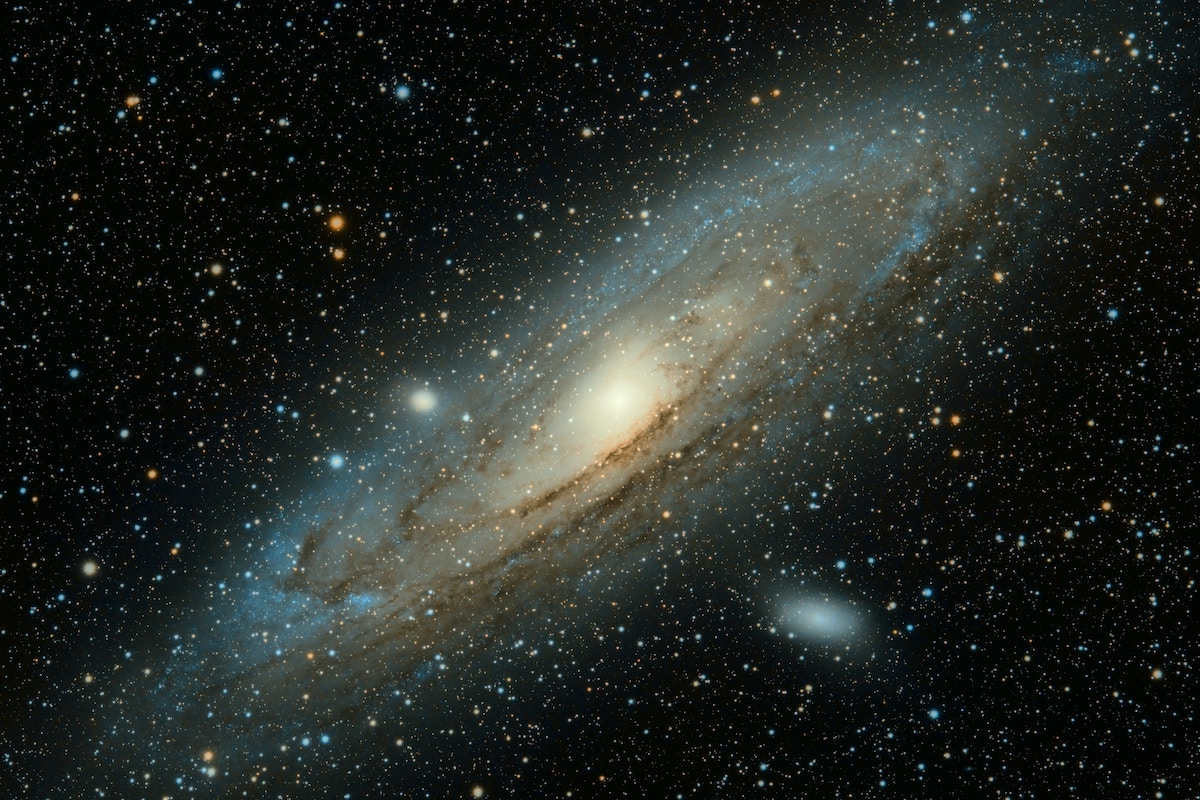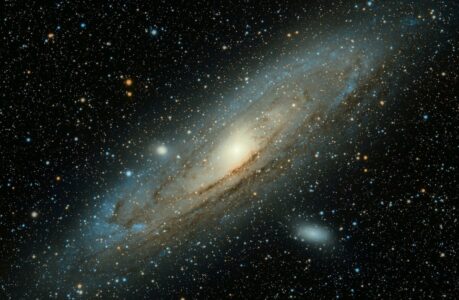In the vast expanse of the universe, dust lanes are among the most intriguing phenomena that have captivated the imagination of astronomers and space enthusiasts alike. These long, narrow bands of dark matter and dust are often seen stretching across the face of galaxies, obscuring the light emitted by stars behind them. In this chapter, we will delve into the fascinating world of dust lanes, exploring their origins, characteristics, and their profound impact on the formation and evolution of galaxies.
Dust lanes are essentially the result of the accumulation of interstellar dust particles in galaxies. These particles can range in size from tiny grains to larger boulders, and they tend to clump together due to gravity, eventually forming these elongated structures. The dust lanes are primarily composed of carbon and silicon-based particles, as well as other heavy elements that are produced in the nuclear reactions of stars.
One of the most prominent examples of dust lanes can be found in the center of our own Milky Way galaxy. Here, a massive dust lane extends for thousands of light-years, dividing the galaxy into two distinct halves. The dust lane is believed to be the result of the gravitational pull of a massive black hole located at the center of the galaxy, which has caused the dust and gas to be drawn towards it.
Dust lanes are not only visually captivating but also play a crucial role in the formation and evolution of galaxies. As dust particles collide and clump together, they can form into larger structures known as planetesimals, which are the building blocks of planets. The accumulation of these planetesimals eventually leads to the formation of planets and other celestial bodies.
Dust lanes also play a crucial role in the regulation of star formation within galaxies. The dust particles absorb and scatter the light emitted by stars, which can prevent the formation of new stars in certain regions of the galaxy. This is because the formation of stars requires a certain amount of light and heat to trigger the gravitational collapse of gas clouds. If these clouds are obscured by dust, then the necessary conditions for star formation may not be met.
On the other hand, dust lanes can also trigger the formation of stars in certain regions of a galaxy. This is because the gravitational pull of the dust can cause gas clouds to compress, which in turn can trigger the formation of new stars. This process is known as gravitational instability, and it is thought to be responsible for the formation of some of the most massive stars in the universe.
The study of dust lanes has also led to some exciting discoveries in the field of cosmology. For example, the observation of dust lanes in distant galaxies has provided astronomers with important clues about the early universe and the processes that led to the formation of galaxies. By studying the distribution and properties of dust lanes in different galaxies, astronomers can gain insights into the history of star formation in the universe.
In recent years, the study of dust lanes has been revolutionized by advancements in technology, particularly in the field of infrared astronomy. Infrared telescopes are able to detect the heat emitted by dust particles, allowing astronomers to study dust lanes in much greater detail than was previously possible.
In conclusion, dust lanes are a fascinating and integral part of the universe, playing a vital role in the formation and evolution of galaxies. Their mysterious and captivating appearance has inspired generations of astronomers and space enthusiasts to explore the secrets of the cosmos. With ongoing advancements in technology, we can expect to uncover even more mysteries and secrets of the universe’s dust lanes in the years to come.
Galaxies with prominent dust lanes
There are several galaxies that are known for their prominent dust lanes, which have fascinated astronomers and space enthusiasts alike. Here are a few examples:
- The Milky Way Galaxy: As mentioned earlier, the Milky Way has a massive dust lane that stretches across its center for thousands of light-years. This dust lane is believed to be the result of the gravitational pull of the supermassive black hole at the center of the galaxy.
- The Sombrero Galaxy: The Sombrero Galaxy, also known as M104, is a stunning galaxy that is notable for its prominent dust lane that stretches across its center. This dust lane is thought to be the result of a collision with a smaller galaxy, which caused the dust and gas to be compressed and form the distinctive band.
- The Centaurus A Galaxy: Centaurus A is a peculiar galaxy that is notable for its prominent dust lane and active galactic nucleus. The dust lane is thought to be the result of a merger with a smaller galaxy, which caused the gas and dust to be compressed and form the band.
- The Antennae Galaxies: The Antennae Galaxies, also known as NGC 4038/9, are a pair of interacting galaxies that are in the process of merging. They are notable for their prominent dust lanes and tidal tails, which are the result of the gravitational interaction between the two galaxies.
- The Whirlpool Galaxy: The Whirlpool Galaxy, also known as M51, is a beautiful galaxy that is notable for its spiral arms and prominent dust lanes. The dust lanes are thought to be the result of a gravitational interaction with a smaller companion galaxy, which caused the gas and dust to be compressed and form the bands.
How can I make dust lanes more visible in astrophotography
Capturing dust lanes in astrophotography can be a challenging task, but there are a few techniques that can help make them more visible in your images. Here are some tips:
- Use a narrowband filter: Narrowband filters allow you to capture specific wavelengths of light that are emitted by ionized gas and dust. These filters can help enhance the visibility of dust lanes in your images. Hydrogen-alpha (Ha) filters and sulfur (SII) filters are particularly effective for this purpose.
- Use longer exposure times: Longer exposure times can help capture more light and bring out the details of the dust lanes. However, it’s important to use a stable mount and avoid overexposing the image, which can result in bloated stars and loss of detail.
- Capture multiple images: Capturing multiple images and stacking them together can help reduce noise and bring out the details of the dust lanes. You can use software such as DeepSkyStacker or PixInsight to align and stack your images.
- Use image processing techniques: Image processing techniques such as stretching, sharpening, and contrast enhancement can help bring out the details of the dust lanes in your images. However, it’s important to use these techniques in moderation to avoid overprocessing the image.
- Choose a dark site: Choosing a dark site with minimal light pollution can help reduce the background noise in your images and make the dust lanes more visible. You can use tools such as Dark Sky Finder to find dark sites near you.
Remember that capturing dust lanes in astrophotography requires patience and practice. Experiment with different techniques and settings to find what works best for your equipment and location.

